There are a lot of video training and video marketing statistics floating around online, and we have compiled the most trustworthy, current, relevant, and/or useful to help inform your internal training and external video marketing strategies. The stats below are sourced from well-respected companies in the video and marketing industries, so you can feel confident about using them.
Why video?
Video marketing was crowned ‘King of Content‘ as early as 2015 and it still holds the title in 2022. Over the next few years, online video viewing is predicted to grow at a compound annual growth rate (CAGR) of 21% from 2021 and 2028. Hundreds of hours of video are uploaded every second, 3.1 billion users worldwide consume video, and billions of video views are happening daily. And to top it off, video consumption is not just for entertainment purposes, as more people are watching videos for learning new skills and fostering a sense of community.
Why video for business?
Consumers are using video to research products before they buy them. Brands are using video to improve their marketing outcomes. And businesses are creating video content to better train and onboard their employees. Without a doubt, video is here to stay, and the following statistics serve as evidence of its popularity and importance.
Demand and Popularity of Video is Increasing
People are watching more video content and paying more attention to video than other types of media.
- By 2021, video will represent 82% of all IP internet traffic. (Cisco, 2017)
- 79% of the global mobile data traffic will be video in 2022. (Cisco, 2019)
- People watch on average 19 hours of online video per week, and an average of 2.5 hrs per day — this is a 5.56% increase compared to 2021. (Wyzowl, 2022)
- In 2019, there were over 2.6 billion digital video viewers worldwide. That number is projected to reach over 3.1 billion by 2023 (Statista, 2021)
- In 2017, 81.1 percent of U.S. online users accessed digital video content. In 2020, this number is projected to be 83.3 percent. (Statista, 2018)
- People pay attention to video content, but they skim or multitask with written content and podcasts. (HubSpot, 2017)
- People spend an average of 2.6x more time on pages with video than without. (Wistia, 2018)
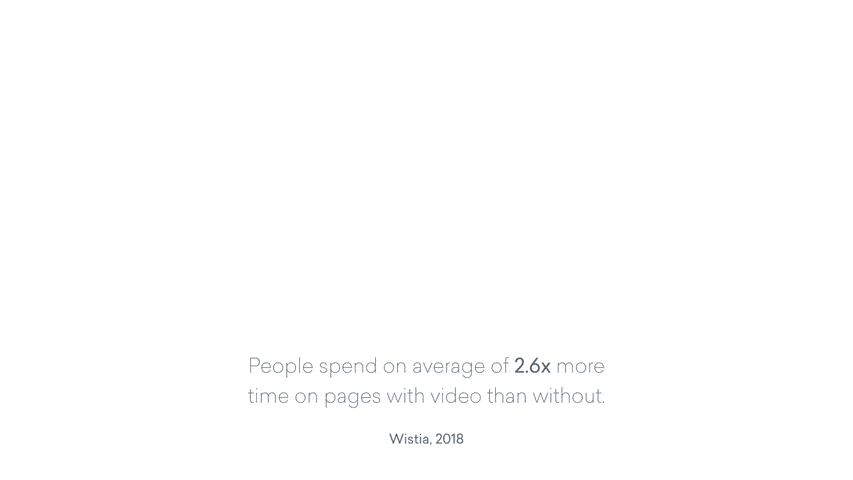
Marketing Videos Are a Great Way to Reach Consumers
“In today’s fast-paced world, video marketing is one of the few types of online material that provides the value, relevance, and flexibility consumers need, all while catering to the on-the-go lifestyle they want.” (Forbes)
Types of Marketing Videos
Marketing videos come in many forms, including explainers, social media videos, product demos, user-generated content or customer videos, and more. According to a 2021 report from Vidyard, the most commonly used business video types are:
| Product Demos (63%) | Training Videos (47%) | Live streams (32%) |
| How-To’s (51%) | Social Video (41%) | Thought Leadership (29%) |
| Explainers (51%) | 1:1 Video (40%) | Internal Communications (29%) |
| Webinars (51%) | Customer Testimonials (38%) | Culture Videos (26%) |
The Benefits of Video for Businesses and Consumers
As video has become increasingly popular, consumers and businesses have found many benefits. 84% of Enterprise organizations report using video for five or more purposes and 28% use video for nine or more (Kaltura, 2018).
Salesforce reports 90% of marketing organizations use video. Moreover, they deemed video as the star channel of 2021. (Salesforce, 2021)
Consumers prefer to learn about a brand and its products Through Video
When it comes to receiving branded content or learning about a business’s products and services, consumers prefer video over other types of content.
- 85% of people would like to see more video from brands in 2021. (Wyzowl, 2021)
- Newer generations consume more video than the previous ones. 1 in 2 Gen Z and Millenials report not knowing how they’d “get through life without video” (Google, 2019)
- From the same Google report, we learn that 46% of global viewers use video content to learn something new. (Google, 2019)
- More than half (54%) of consumers prefer to see video content from a brand than other types of content. (Hubspot, 2017)
- Two-thirds of people (66%) said they’d prefer to watch a short video to learn about a product or service rather than read a text-based article, website, or post (18%); view an infographic (4%); download an ebook or manual (3%); attend a webinar (3%); receive a sales call or demo (2%). (Wyzowl, 2020)
- 43% of survey respondents say that branded video is the most memorable type of content shared by companies. (HubSpot, 2017)
- 94% of people have watched an explainer video to learn more about a product or service. (Wyzowl, 2021)
- When researching new products and services to make B2B purchasing decisions, millennials prefer video-based content (29%) more than a case study (19%), white paper (16%), brochure (15%), webinar (11%), or infographic (11%). (Merit, 2017)
- 84% of people say that they’ve been convinced to buy a product or service by watching a brand’s video. (Wyzowl, 2021)
- 79% of people say they’ve been convinced to buy or download a piece of software or app by watching a video. (Wyzowl, 2021)
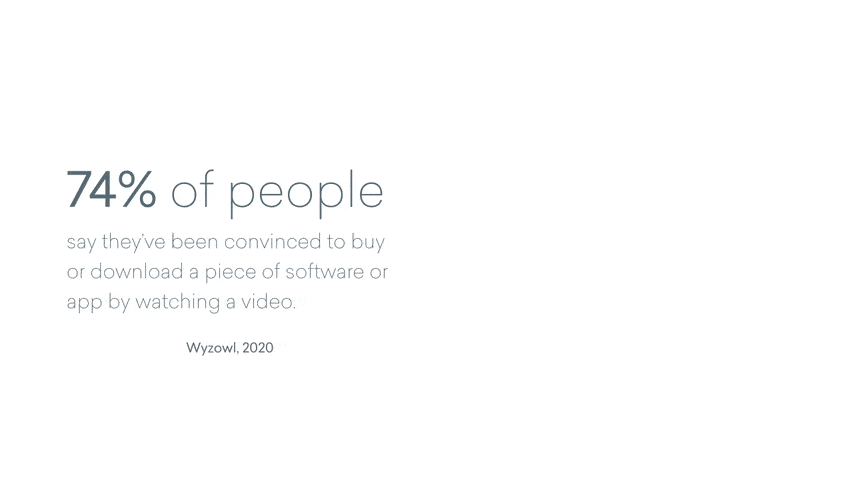
Consumers seek out video to help them make purchasing decisions
Many consumers have searched for videos on Google or YouTube to help them decide what products to buy.
- More than 55% of people search for a product on Google and then learn more by going to YouTube before they buy it. (Google, 2018)
- Top three reasons people watch a video after using search when researching products to buy: 1. To see a product before they buy it or to see how others have used it; 2. To learn more about a product they have in mind; 3. To see credible or authentic reviews from others. (Google, 2018)
- Nearly 50% of internet users look for videos related to a product or service before visiting a store. (Google, 2016)
- Over 70% of shoppers say online video has helped them learn more about an auto product they intended to buy. (Google, 2019)
- 50% of electronics shoppers say they purchased products they discovered on YouTube. (Google, 2018)
- Video searches for ‘which [product] should I buy’ doubled from 2017 to 2018. (Google, 2018)
Video Helps with Learning, Training, and onboarding
- Nearly 75% of enterprise companies are using video for internal learning and development and 98% see video use in their organization as steady or growing. (Kaltura, 2018)
- Many employees, regardless of remote status or age, wish their company offered more types of training (60%) and they were available on-demand (65%) and there were different levels available (65%). (Vyond, 2022)
- Employees mostly prefer self-led online training [like video] (51%), followed by instructor-led training (47%). (Vyond, 2020).
- “Enterprises see a high value for video, especially for video communication and learning. 98% say video is valuable for improving communication and for training employees better and faster. Other areas in which video is thought to have a positive impact include connecting geographically-dispersed employees (95%), increasing brand awareness and lead generation (93%), and empowering employees to share knowledge (93%).” (Kaltura, 2018)
- According to a survey by the Association for Talent Development (ATD), 72% of organizations plan to create microlearning videos in the near future, if they aren’t already. (ATD, 2017)
- Psychologist Richard Wiseman’s research shows that whiteboard animation leads to greater retention. His study determined an astounding 15% increase in recall in the test takers who viewed a whiteboard animation versus those who didn’t. (Wiseman, 2013)

- 98% of enterprise organizations site video as being valuable for “Improving communication” and “Training employees better/faster. (Kaltura, 2018)
- 4 in 5 people said digital video helps them learn new things. (YouTube Data, 2017-1018)
- Google searches for online courses grew by over 70% globally between the last week of March and the first week of April 2020, while global YouTube watch time for lectures on spoken languages have grown more than 6X year over year. (Google, 2020)
- Google asked 12K viewers aged 13-64 the number one reason why they watched what they watched in the past 24 hours.‘Teaches me something new’ was the second-most popular choice. (Google, 2020)
- In one 2014 study, 80% of respondents believed that video would have a positive impact on making the onboarding process smoother for new employees. 87% also believed that video would have a positive impact on training employees faster, and more cost-effectively (Kaltura, 2014)
Video gives marketers a significant return on investment
With video growing in popularity and consumers using video to make purchasing decisions, it’s not surprising that marketers are finding significant ROI from marketing videos.
- 95% of video marketers say video has helped increase user understanding of their product or service. (Wyzowl, 2020)
- 87% of video marketers say video has increased traffic to their website. (Wyzowl, 2020)
- 83% of video marketers say video has helped them generate leads. (Wyzowl, 2020)
- 81% of video marketers say video has helped increase the average time their visitors spend on a page. (Wyzowl, 2020)
- 80% of video marketers say video has directly helped increase sales. (Wyzowl, 2020)
- 43% of video marketers say video has reduced the number of support calls they’ve received. (Wyzowl, 2020)
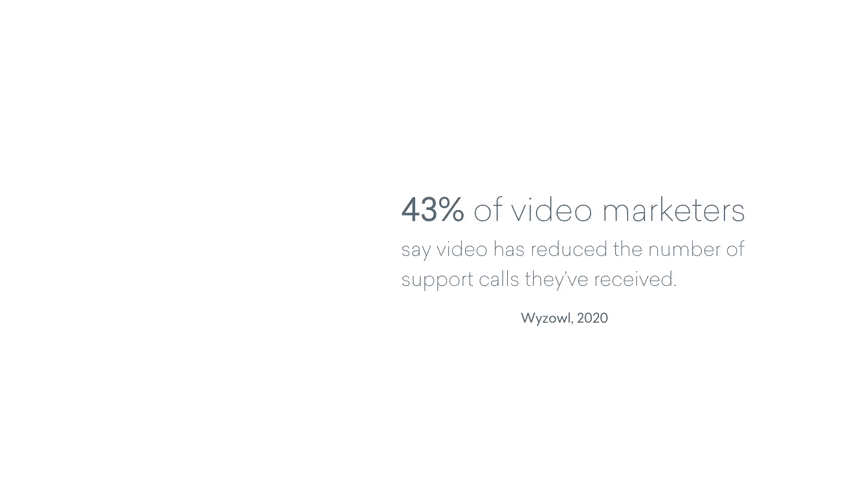
- 89% of video marketers say video, in general, gives them a good return on their investment. (Wyzowl, 2020)
- 99% of people who use video for marketing say they’ll continue using video in 2020. (Wyzowl, 2020)
- 18% of first-time video marketers started using video in 2019 because they feel clearer about the ROI of video. (Wyzowl, 2020)
- 92% of marketers who use video say that it’s an important part of their marketing strategy. (Wyzowl, 2020)
- 95% of video marketers plan to increase or maintain their spend on video in 2020. (Wyzowl, 2020)
- The average success rate of video marketers, across all platforms, is incredibly high. On average, where marketers use video channels, 79% of them report success—although this number differs across platforms. (Wyzowl, 2020)
Marketing videos have become easier and more cost-effective to make
Many non-video marketers have recently added video to their marketing strategy because they believe they are easier and more affordable to create.
- 47% of first-time video marketers started using video in 2019 because they believe it’s become quicker and less time-consuming to create video content. (Wyzowl, 2020)
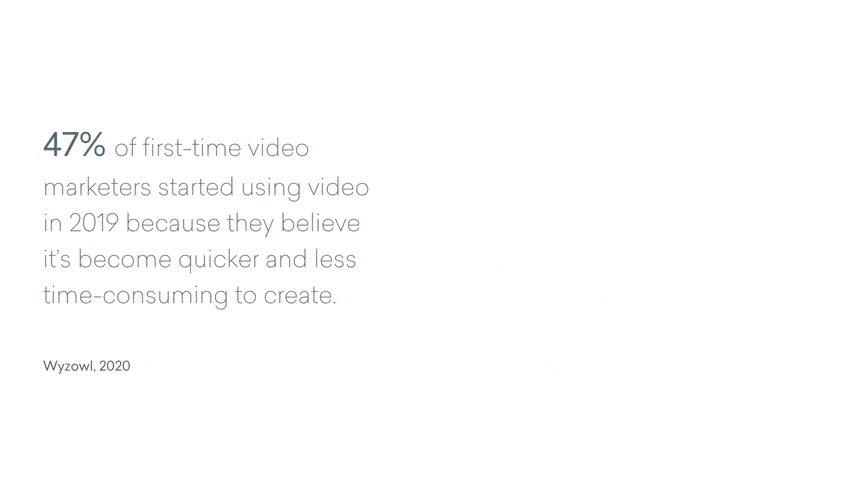
- 48% of first-time video marketers got started with video because they found it easier to convince others in the business of its value. (Wyzowl, 2020)
- 46% of first-time video marketers started using video in 2019 because they believe video is becoming more affordable and because it’s easier to create video content in-house. (Wyzowl, 2020)
Video Improves Email Marketing Results
Including video in your marketing emails can increase your click-through rate.
- Including video thumbnails instead of images in your email can increase clicks by over 21%. (Wistia, 2017)
- In a single quarter, one Vyond customer experienced a 130% increase in click-through rate (CTR) for emails with animated video compared to the CTR for emails without animated video. (Vyond, 2017)
Social Media is a Prime Destination for Video Marketing
With so many platforms to choose from — Facebook, YouTube, Instagram, Twitter, etc. — and billions of users among them, social media is a prime destination for brands to place their marketing videos.
- Videos are consumers’ favorite types of content to see from a brand on social media. (Animoto, 2018)
- On social media, video ads are the number one way consumers have found out about a new brand/product before purchasing. (Animoto, 2018)
- 93% of marketers say they’ve landed a new customer thanks to a video on social media. (Animoto, 2018)
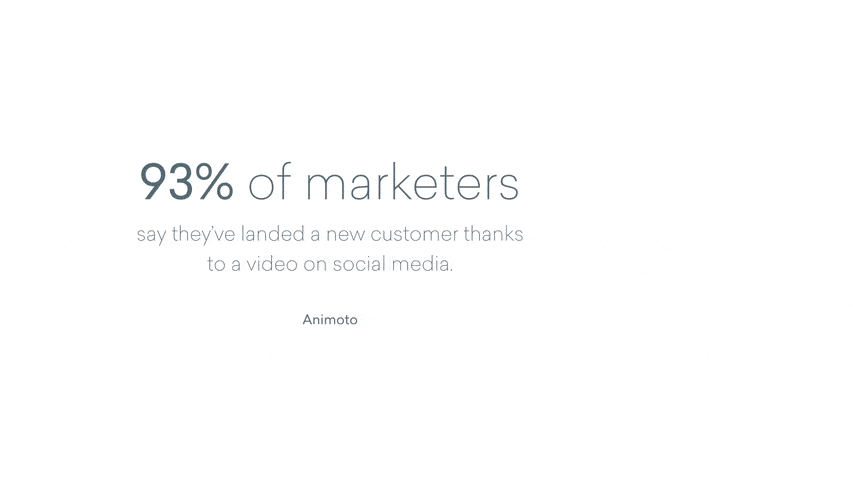
- 88% of marketers are satisfied with the ROI of their video marketing efforts on social media. (Animoto, 2018)
- 80% of marketers feel good about the ROI of video ads posted on social media. (Animoto, 2018)
- Facebook, YouTube, and Instagram are the top three platforms for marketers posting social marketing videos and video ads. (Animoto, 2018)
- Social media is the number one reason marketers named for creating videos in the last 12 months. (Animoto, 2018)
- 73% of marketers create at least two videos a month for social media. (Animoto, 2018)
YouTube Video
With hundreds of hours of video uploaded every minute and its popularity among users 18-34, YouTube has become a key platform for video marketing.
- People upload 500 hours of video to YouTube every minute. (Statista, 2020)
- The average YouTube watch session on mobile lasts more than 60 minutes. (CNET, 2018)
- More than 70% of what users watch on YouTube is driven by its recommendation algorithm. (CNET, 2018)
- On mobile in an average week, YouTube reaches more 18+ year-olds during prime-time TV hours than any cable TV network. (Google, 2017)
- Two-thirds of YouTube users watch YouTube on a second screen while watching TV at home. (Google, 2017)
- 50% of viewers aged 18-34 said they would stop what they were doing to watch a video from their favorite creator. (Google, 2017)
- 65% of people use YouTube to help them solve a problem. (Google, 2018).
- 88% of video marketers plan to include YouTube in their 2020 video marketing strategy. (Wyzowl, 2020)
- YouTube remains the most widely used platform for video marketers, with 85% of video marketers using it in 2019. (Wyzowl, 2020)
- 83% of video marketers that have used YouTube said it had been successful for them. (Wyzowl, 2020)
- The number of channels reaching 1+ million subscribers increasing by more than 65% year over year. (YouTube, 2020)
Facebook Video
While YouTube is the social destination for video, Facebook has gained traction as a video destination for users and marketers.
- Videos are becoming increasingly popular post types, accounting for about 11% of Facebook posts. (Quintly, 2019)
- Square Facebook videos get 35% more views than landscape videos. (Buffer, 2017)
- It costs 7.5% less to get someone to engage with square video on Facebook. (Buffer, 2017)
- 65% of people surveyed say they watch publisher video on Facebook every day, while 35% watch multiple times per day. (Facebook, 2019
- 94% of survey respondents who watch a publisher video report sharing it. (Facebook, 2019)
- 62% of people said they were more interested in a product after seeing it in a Facebook story. (Facebook, 2018)
- Facebook has become more effective as a video marketing channel than YouTube, with 79% of video marketers using it — and 85% of those people say it’s been a success. (Wyzowl, 2020)
- 76% of video marketers plan to include Facebook in their 2020 video marketing strategy. (Wyzowl, 2020)
- 32% of video marketers plan to include Facebook Live in their 2020 video marketing strategy. (Wyzowl, 2020)
- 81% of marketers have placed spend against a video on Facebook. (Animoto, 2018)
- Facebook is the top organic and paid social media platform B2C marketers use. (Content Marketing Institute, 2019)
Instagram Video
Many consumers are watching branded video on Instagram through its feed, IGTV, and Stories, making it a key platform for marketers’ video marketing strategy.
- 49% of consumers have watched video on IGTV; of those, 70% have watched an IGTV video from a brand. (Animoto, 2018)
- 28% of video marketers plan to include Instagram TV in their 2020 video marketing strategy. (Wyzowl, 2020)
- 47% of consumers enjoy watching ads on Instagram Stories. (Animoto, 2018)
- 74% of marketers have posted at least two videos on Instagram Stories a month. (Animoto, 2018)
- 65% of video marketers plan to include Instagram in their 2020 video marketing strategy. (Wyzowl, 2020)
Twitter Video
Though not as popular for video marketing as Facebook, YouTube, or Instagram, Twitter is still an important part of many marketers’ plans.
- There are over 2 billion video views on Twitter each day, which is 67% YoY growth, according to Twitter’s internal data. (Twitter, 2020)
- Tweets with video attracted 10x more engagements than Tweets without video. (Twitter, 2020)
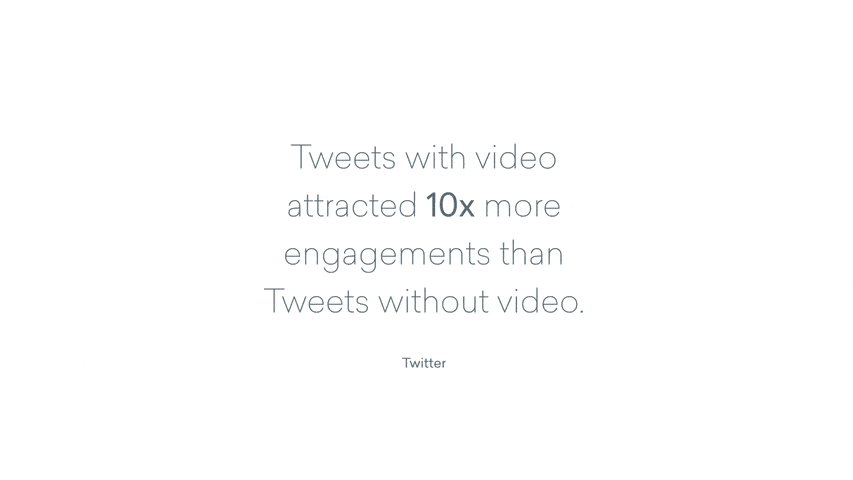
- Promoted Tweets with videos save more than 50% on cost-per-engagement. (Twitter, 2020)
- 93% of video views happen on mobile. (Twitter, 2020)
- Keep your Tweets short: Videos with minimal Tweet copy vs. longer Tweet copy have a 13% higher brand and message recall and overall view time. (Twitter, 2020)
Ready to Get Started with Video?
Now that you’ve read how marketing videos can benefit your business, if you’re ready to get started making videos, here are some best practices.
Keep it short, but not too short
- Video engagement remains at 51% for videos less than a minute long. The engagement slowly decreases as the video length is increased. To a minimum engagement of 16% at 60+ minutes. (Wistia, 2022)
- The video completion rate for 15-second clips sits at nearly 90%. (KoMarketing, 2020)
- 60% of videos are less than 2 minutes long. (Vidyard, 2021)
- In one experiment, 30-second ads had a 30% higher view-through rate (VTR) than 15-second ads. (Google, 2016)
- 45% of viewers watch a video all the way through regardless of its length. This is a decrease compared to 2019 (52%). Just over half (58%) of viewers watch a video to the end if it’s less than 60 seconds, but only 24% will finish a video if it’s more than 20 minutes. (Vidyard, 2021)
- Younger generations are more likely to seek out short-form content such as webisodes, tutorials, and short video clips produced by professional and amateur creators. User-generated content is often short form, and younger viewers are more likely to watch both. (Google, 2020)
- Videos that are longer than 20 minutes only get about 24% audience engagement. While Videos that are less than a minute long get 58%. (Vidyard, 2021)
- A Vyond customer reports that 75% of viewers watched up to two minutes of a job aid training video. The percentage of viewers dropped off significantly after the two-minute point. (Vyond, 2019)
Have a distribution strategy
- The majority of business-related video views (87%) still take place on desktop computers. (Vidyard, 2019)
- Chrome is the top browser by a wide margin, with nearly two-thirds (61%) of video watchers using the browser. This is followed by Internet Explorer, which, at 15%, has fallen significantly year-over-year. (Vidyard, 2019)
- Audiences watch business video content more on Thursdays than any other day of the week — 22% of views happen then. (Vidyard, 2019)
- Websites, social media, and landing pages are three of the most popular places to embed video content. (Vidyard, 2019)
Use captions
- 92% of consumers view videos with the sound off on mobile. (Verizon, 2019)
- 80% of consumers are more likely to watch an entire video when captions are available. (Verizon, 2019)
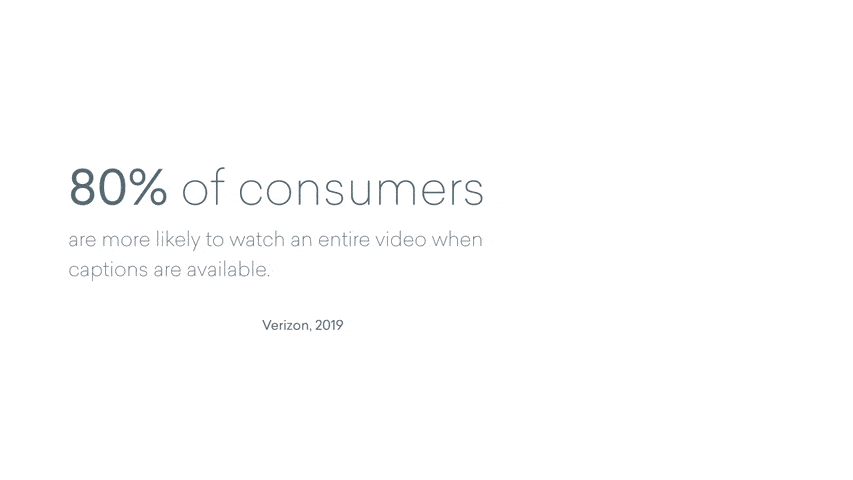
- When captions are available, 37% of viewers said they are encouraged to turn the sound on because the videos seem more interesting, and 29% said that even with the sound off, they were better able to understand the video because of the captioning. (Verizon, 2019)
Consider Animated Video
- By switching to animated video, a Vyond customer experienced a 67% reduction in onboarding time for a group of new employees. (Vyond, 2017)
- In a single quarter, a Vyond customer saw a 130% increase in the click-through rate (CTR) for emails with animated video compared to the CTR for emails without animated video. (Vyond, 2017)
- Another customer experienced a 375% boost in video shares on social media and a 21% increase in YouTube views by adding animated video. (Vyond, 2015)
- By using Vyond to create more than 200 animated videos, one customer saved between $600,000 and $1.4 million in production costs and saved their clients’ HR team more than 2,000 hours in unproductive meetings. (Vyond, 2016)
- Conversion rates jumped 67% when MailLift added an animated explainer video to their homepage. (Vyond, 2015)
- A Vyond customer reports saving eight hours per week on video content production by adding animated video to their previously Adobe-only toolkit. (Vyond, 2016)
Training & Video Marketing Statistics Show the Benefits of Video
Whether you’re looking to help customers learn more about your products, improve your marketing ROI, or increase your email click-through rate, these statistics show the benefits of incorporating video into your marketing strategy.
Create your own animated videos. Start a 14-day free trial of Vyond.